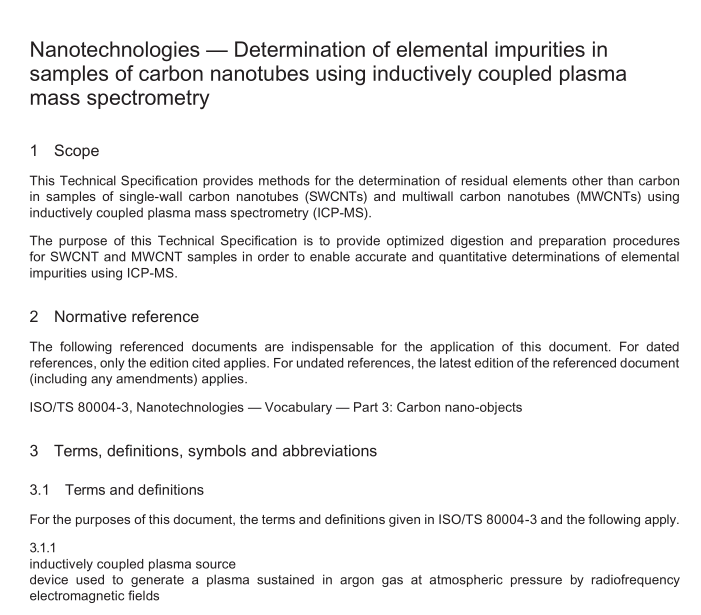DD ISO TS 13278 pdf download

DD ISO TS 13278 pdf download Nanotechnologies — Determination of elemental impurities in samples of carbon nanotubes using inductively coupled plasma mass spectrometry
5 Apparatus Use an ICP-MS instrument with a quadrupole or sector field mass spectrometer, or another type of ICP- MS instrument operating with at least 1 u (atomic mass unit) resolution for multi-element determinations.
It is recommended that CCT or DRC technology [12][13][14][15][16] be used, if available, to efficiently remove or minimize spectral interferences. 6 Sample pretreatment
6.1 Sample preparation for ICP-MS analysis Harmonizing sample preparation procedures by using a protocol such as that described in References [12] and [14] contributes to the quality of measurements by improving repeatability, reproducibility and reliability. This in turn ensures that measurement results can be compared with those generated in other laboratories. Given that different laboratories might have different types of sample preparation equipment, it is helpful to provide more than one option for pretreatment of CNTs. Three different sample pretreatment methods, which can be found in Reference [12], are described here. These include wet digestion under high pressure, a combination of dry ashing with wet digestion, and a microwave-assisted sample preparation for dissolution of elemental impurities in the CNT samples before ICP-MS analysis. These methods have been shown to provide reliable and reproducible measurement results using ICP-MS [12] .
They are all equivalent. Among the three procedures described, the appropriate choice for a particular laboratory can be made on the basis of the available equipment or other laboratory-specific factors, as well as a consideration of possible sample effects. If elements of high volatility that are subject to thermal losses, such as Hg, Se, and As, are to be determined, then samples shall be digested using closed microwave-assisted acid digestion systems or sealed PTFE vessels under high pressure. In each of the following procedures, a selected number of “spiked” samples shall be prepared with each batch of “unspiked” samples. The number of spiked samples shall be at least 10 % of the number of unspiked samples. The purpose of the spiked samples is to allow analyte recovery to be calculated. Spike recovery is described in 8.2.
6.2 Wet digestion under high pressure a) Select the desired number of PTFE digestion vessels, taking into account the fact that each vessel will be used to prepare one sample, as well as the desired number of spiked samples. Label the vessels that will contain spiked samples with the word “spiked”, the other vessels are labelled with the word “unspiked”. b) Weigh 10 mg to 20 mg of the CNT sample into each vessel.
NOTE 1 PTFE vessels typically have a static charge, making it difficult to accurately weigh mg samples directly into the vessel. The accurate weight of a 10 mg to 20 mg sample in PTFE vessels is calculated from the weight difference between the absence and presence of CNT sample. NOTE 2 If 10 mg of CNT material might not be sufficient to provide a homogenous and representative sample, the CNT material is homogenized in advance.
c)Add to each vessel 4 ml of a mixture containing three parts by volume concentrated HNO3 and one partby volume 3 % mass fraction H2O2.
d)Pipette 0,1 ml or more of the appropriate stock spike solution(s) into each vessel labelled “spiked”.
NOTE3 One or both spike solutions are used, depending on the impurities remaining in the samples of carbonnanotubes.
e)Seal the PTFE vessels inside oxygen combustion bombs (one vessel per bomb).
f) Heat the bombs in an oven at 180 °C and at a gauge pressure of 4 MPa for 12 h; then remove the bombs
and allow them to cool to room temperature.
gOpen the bombs to see if digestion is complete, as indicated by the absence of any black residue. Ilf it is
complete, proceed to step h) f it is incompliete, add a 4 ml to 6 ml aliquot of the same mixture used in stepc) to each vessel and repeat steps e) to g) until digestion is complete. Three or four heating cycles aretypically necessary.
h) Evaporate each digested solution to incipient dryness (almost dryness).Then add 2 %(volume fraction)
HNO3 to a fixed volume (e.g. 3 ml). Dilute further using 2 %(volume fraction) HNO3 if necessary forICP-MS analysis.
NOTE4 Sinceevaporationnecessitatesanopenvessel,careshouldbetakentominimizethepotentialforcontamination.e.g. using HEPA-filtered environment.
6.3 Combined dry ashing and acid digestion
a)Select the desired number of quartz crucibles, taking into account the fact that each crucible will be used
to prepare one sample, as well as the desired number of spiked samples.Label the crucibles that willcontain spiked samples with the word “spiked.”
b)Weigh between 25 mg and 50 mg of the CNT sample into each quartz crucible.
)Pipette 0,1 ml of the appropriate stock spike solution(s) into each vessel labelled “spiked.”
NOTE1 One or both spike solutions are used, depending on the impurities remaining in the samples of carbonnanotubes.
d)Place the crucibles in a muffle furnace for more than 5 h at a temperature that is appropriate for the
composition of the samples being ashed.
NOTE2 The burning temperature of amorphous carbon is 350 °℃.SWCNTs decompose at a temperature of about500 °C or higher, while MWCNTs decompose at a temperature between 600 “C and 700 ℃C, under the above mentionedconditions.When the composition of an unknown sample is not well-characterized, a temperature of 750 “C should beused.
NOTE3 When spiked samples are to be ashed,care should be taken to ramp the temperature to slowly evaporate thesolvent; otherwise the spike can sputter, resulting in analyte loss.
e)Remove the crucibles from the muffle furnace to a desiccator and allow them to cool to room temperature.
Then completely transfer the resultant ashes into PTFE vessels using 3 ml to 4 ml hot (50 °C)concentratedHNO3.









